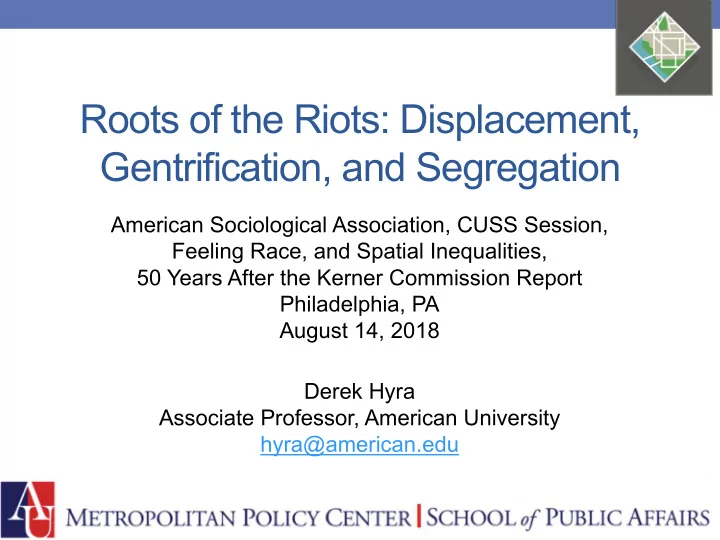

Roots of the Riots: Displacement, Gentrification, and Segregation American Sociological Association, CUSS Session, Feeling Race, and Spatial Inequalities, 50 Years After the Kerner Commission Report Philadelphia, PA August 14, 2018 Derek Hyra Associate Professor, American University hyra@american.edu
Overview • Part I. Motivation, background, & argument • Part II. Methods • Part III. Preliminary findings (in Baltimore)
Motivation France, 2005
Baltimore 2015 Ferguson 2014 Charlotte 2016
Some Riot Theory Camps • Ethnic succession and competition (Herman 2005) • Segregation and absolute deprivation (Gale 1996; Sugrue 1996) • Segregation and relative deprivation (Clark 1965; Katz 2012; Wacquant 2008)
Recent Riot Research and Gaps • Several scholars focus on aggressive police actions (Boyles 2015; Butler 2017; Hill 2016; Lowery 2016; Schneider 2014) • Few recent riot studies on structural factors (e.g., displacement, gentrification, segregation, and racial inequality) (except Dikeç 2017) • Few investigations of the Obama effect and administration’s Great Recession policy responses (2009-2016) (DeFilippis 2016) • Few studies compare past to present (1960s vs. 2010s riots)
Initial Research Questions • What comprehensive set of conditions is associated with modern-day U.S. riots? • How do past riot conditions compare to contemporary riot circumstances?
My Initial Hunches/Arguments • Intense frustrations and riots occur when racial and spatial inequalities are perpetuated, over time, by state-led (national and local) aggression. • Within a context of the Obama effect: - heightened African-American (AA) expectations for a better economic future.
Part II. The Comparative Method
Method and Data Collection Multiple case study of three U.S. riot cities • Ferguson, Missouri • Baltimore, Maryland • Charlotte, North Carolina Data Collection • Descriptive statistics: national and local patterns of - *Public housing demolition, gentrification, segregation, & concentrated disadvantage *AA expectations • Newspaper archive, 2014-2016 • Interviews, 25 per city
Part III. The Baltimore Case
Accumulating State-led Aggression Obama Public housing demolition effect: H&C Inner-city gentrification Frustration Riots Deprivation Segregation Alienation Great Recession fallout Police killings
Downtown and the Inner Harbor
“Baltimore Booms,” 1994-1999
Central City Demolitions in the 1990s and Gentrification in the 2000s Central City Demolition Corridor Source: Governing Magazine, February 2015
Changing Neighborhood Income Levels Source: Wall Street Journal, August 5, 2016
Baltimore’s Segregation Patterns 1960 2010 2015 Riot Area Source: U.S. Census
Foreclosures by Neighborhood Racial Composition, 2008-2010* 2015 Riot Area The Great Recession fallout Source: Rosenblatt & Newman 2011
West Baltimore’s Concentrated Disadvantage
National Context: The Hope & The Reality The Hope, 2007 vs. 2009 The Reality, 2009-2016 AA wealth AA perceptions: $1.1 trillion home equity lost • Increased financial security in AA communities Source: Center for Responsible Lending 2013 • Improved race relations AA homeownership rate • Reduced racial inequality Down 5 percentage points during Obama’s terms Source: Pew Center Survey 2010 Source: U.S. Census The Great Black The Obama effect Depression
Widening Wealth Inequality
Add the Police Killings Michael Brown: August 9, 2014, Ferguson Freddie Gray: April 12, 2015, Baltimore Keith Lamont Scott: September 20, 2016, Charlotte
Baltimore Explodes, 2015
Preliminary Finding and Next Steps Finding/Hunche • Multiple state-led aggressions , over time, with racial and spatial inequality consequences, in a context of heightened AA expectations (the Obama effect) , help to understand AA frustrations and the riots. Next Steps • Interviews • Historical comparisons (1960s to 2010s riots)
Closing Thoughts “[U]prisings are all outcomes of deep-rooted grievances, of long histories of exclusion of and violence perpetrated against particular populations. They are not reactions to isolated incidents…” - Mustafa Dikeç, 2017 ____________ We must minimize police brutality but also address other forms of aggression and marginalization (i.e., displacement, gentrification, segregation, & inequality ).
Recommend
More recommend